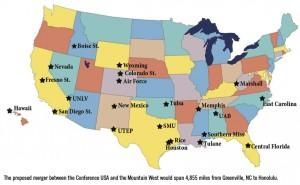No headline provided

September 15, 2011
Athletic Director Rick Dickson’s remarks during a visit to a Lawand Practice of Sports Business Management class two weeks agoignited campus discussion about the idea of a combined MountainWest Conference and Conference USA.
More than a year ago, news broke about talks between officialsfrom both the Mountain West Conference and Conference USAconcerning a potential collaboration. The proposed 22-teamsuperconference would challenge the Bowl Championship Series tobecome its seventh automatic qualifier, joining the Pac-12, Big 12,Big Ten, ACC, SEC and Big East conferences. The five BCS bowlswould no longer be an exclusive club to the 12 teams from the C-USAand 10 teams in the Mountain West. Recently, prognosticators havelabeled the idea the Louisiana Purchase Conference.
In response to a student’s question, Dickson said that he hadrecently spoken on the phone with the Hawaii athletic directorconcerning a two-conference merger. Dickson also said that the twoconferences hope to become the seventh automatic qualifier in theBCS. Dickson was unavailable for comment, but Tulane UniversityDirector of Public Relations Mike Strecker said that Dickson’sstatements were made in jest.
Through Strecker, Dickson said that his statement was “jokinglysaid” and not meant to be taken seriously. Senior Sam Furman,sophomores and Hullabaloo staffwriters Max Resnik and John Owens,who sat in the class, however, said that Dickson spoke earnestlyand they do not believe Dickson joked.
The Hawaii athletic department said it could neither confirm nordeny the report, and repeated efforts to reach Hawaii athleticdirector Jim Donovan via phone and email were unsuccessful. Tostart the 2012 season, the Mountain West loses Texas Christian andadds Hawaii, Nevada and Fresno State. This season, Boise Statebegins its first season as a Mountain West member.
C-USA commissioner Britton Banowsky issued a press release inAugust 2010 discussing the possibility of a merger and said thatofficials from both conferences were in discussions aboutscheduling, TV contracts and related matters.
“The conferences have much in common and have workedcooperatively for many years, and we are exploring creative ways towork together going forward,” Banowsky said in the pressrelease.
C-USA official Courtney Archer said there is no official leaguepolicy pertaining to contact between teams in differentconferences. Archer reiterated that both leagues are cooperativeand maintained that no policy exists barring discussions betweenschools. The Mountain West agrees in principle.
“There’s no official policy,” Mountain West conference officialJavan Hedlund said. “Any institution can talk to whom they wantwhenever they want. We have no policy that athletic directors can’ttalk together because neither one of them can move without talkingto someone else.”
Hedlund said that to his knowledge, there had been no furthercontact between schools involved in the potential newly-combinedconference.
Strecker confirmed that at Tulane, both the President’s Officeand the Athletic Department hold equal status in thedecision-making process.
The current NCAA landscape is filled with uncertainty, andschools all over the nation have been swapping conferenceallegiances and sometimes breaking off century-old rivalries. Thelooming prospect of NCAA megaconferences ranging from the Pac-16 toa 16-team SEC are taking a step closer to reality. As more studentsare now beginning to perceive, C-USA member Tulane is not immunefrom the sea of change.
The ultimate benefit of the proposed merger might be tootempting for either conference to ignore. Joining the same playingfield as the SEC and the Big Ten could be important enough for bothconferences to work out the logistical problems. Teams like Tulaneand Southern Miss would be forced to complete routine roadtrips tothe exotic locales of Laramie, Wyoming and Boise, Idaho. That,however, is not a guarantee. A stipulation of the potential Pac-16includes a promise of Eastern and Western divisions – meaning thatthe Texas, Oklahoma, and Arizona institutions would play each othermore than the schools on the western seaboard. Such a scenariowould likely occur in the new hybrid of the C-USA and MountainWest. Tulane’s football program would, as a member of the 22-teamconference, see a rise in status.
The conference realignment situation remains in a constant stateof flux. The Mountain West could stay separate and add Big 12refugees such as Kansas, Kansas State and Missouri. Big Eastrefugees could join the C-USA. A combination of those two couldhappen. While the C-USA is no stranger to adding and losingdifferent members – consider the 2005 exit by five schools -today’s NCAA conference realignment possibilities have alreadysignaled a new era in college athletics, and Tulane will likely beaffected moving forward into the future.









Leave a Comment